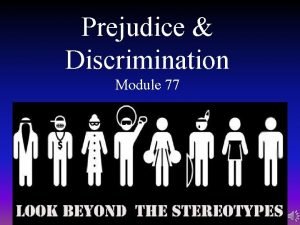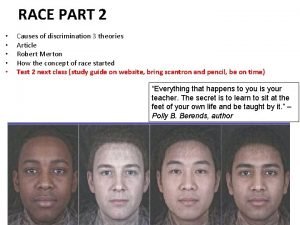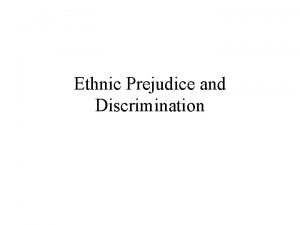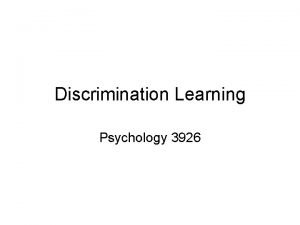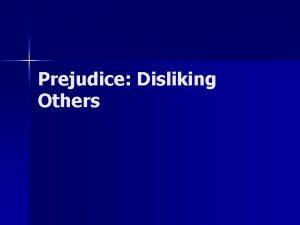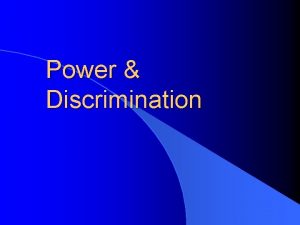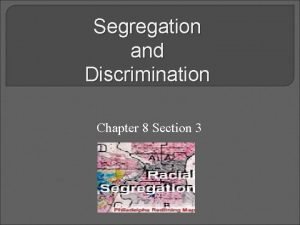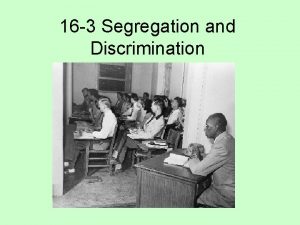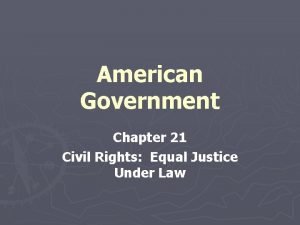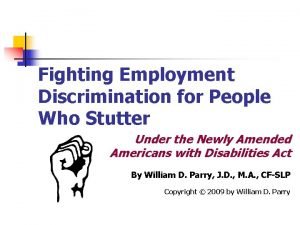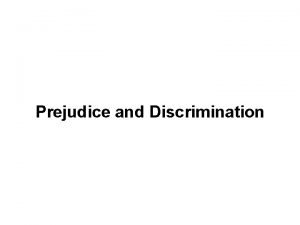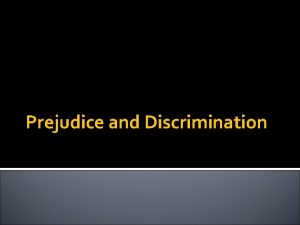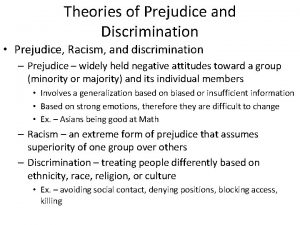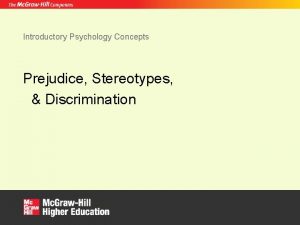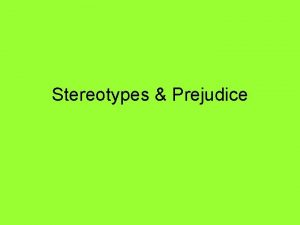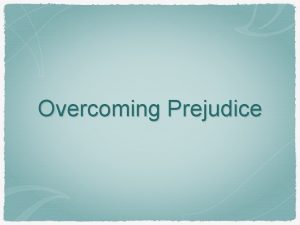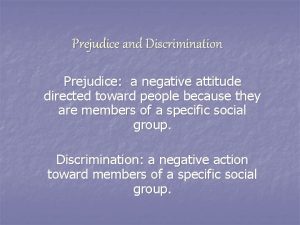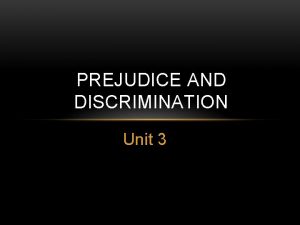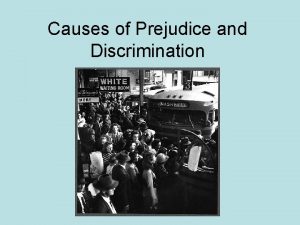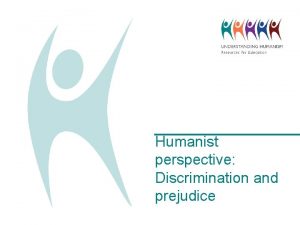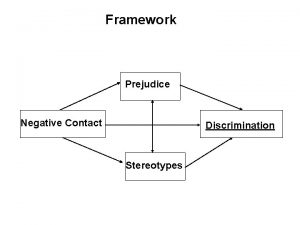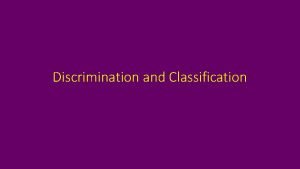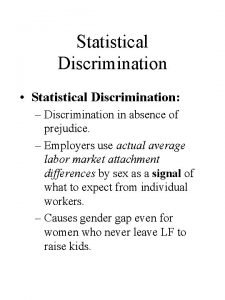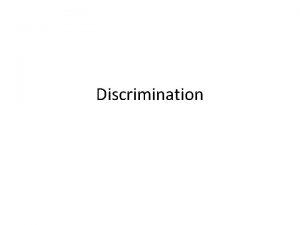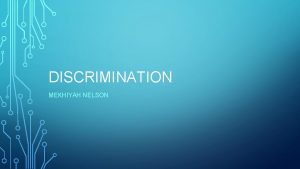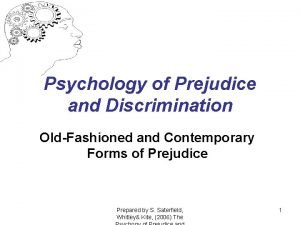The Psychology of Prejudice and Discrimination From Prejudice


























- Slides: 26

The Psychology of Prejudice and Discrimination From Prejudice to Discrimination Chapter 10

What is Discrimination? • Discrimination consist of behaving differently towards people based solely or primarily on their membership in a social group • Prejudice is an attitude—deals with how people think and feel about members of other groups.

What is Discrimination? • Discrimination – – Can manifest itself in may ways and in many settings • Verbally • Behaviorally Nov 2006 Prepared by S. Saterfield for Whitly & Kite, 2006

Socially Approved and Disapproved Prejudices Approved • • • • % Rapists Child abusers Child molesters Wife beaters Terrorists Racists Members: Ku Klux Klan Drunk Drivers Members of the American Nazi Party Pregnant women who drink alcohol Men who refuse to pay Child support Negligent parents People who cheat on their spouses Nov 2006 98 98 97 97 95 92 91 91 90 89 89 86 82 Disapproved • • • • Mentally retarded people Native Americans Black Americans Jews Catholics Whites Hispanics Asian Americans Canadians Ugly people Interracial couples People with AIDS Fat people % 3 6 6 7 7 10 11 11 11 Groups for which prejudice and discrimination had the highest and lowest approval ratings Prepared by S. Saterfield for Whitly & Kite, 2006

Forms of Discrimination Denokraitis and Feagin (1995) developed system to classify forms of discrimination and to show they related to one another. Three forms of discrimination— – Blatant – Subtle – Covert Nov 2006 Prepared by S. Saterfield for Whitly & Kite, 2006

Forms of Discrimination Blatant Discrimination – Unequal and harmful treatment – Typically intentional – Quite visible – Easily documented Also occurs in everyday contexts Some forms against groups are illegal and generally condomned Nov 2006 Prepared by S. Saterfield for Whitly & Kite, 2006

Forms of Discrimination Subtle Discrimination – Unequal and harmful treatment – Typically less visible and obvious than blatant discrimination – Often noticed because people have internalized subtle discriminatory behaviors as “NORMAL”, “NATURAL”, or “CUSTOMARY” – Harder to document – Often unintentional – Can be manifested in everyday speech Nov 2006 Prepared by S. Saterfield for Whitly & Kite, 2006

Forms of Discrimination The Language of Prejudice Some of the most common examples of subtle prejudice can be found in everyday speech. – Hostile humor – Patronizing – Vanishing – Abnormalization – Linguistic devices Nov 2006 Prepared by S. Saterfield for Whitly & Kite, 2006

Forms of Discrimination Covert Discrimination Consist of unequal and harmful treatment that is • Hidden • Purposeful • Often maliciously motivated Behavior that consciously attempts to ensure failure Very difficult to document Nov 2006 Prepared by S. Saterfield for Whitly & Kite, 2006

Forms of Discrimination Covert Discrimination Employment context— Tokenism—hiring one or a few members of group as evident that organization does not discriminate Containment—restricting members of group to limited number of job categories Sabotage—arranging for members of a group to fail; assigning them low volume territories but setting sales quotas very high Nov 2006 Prepared by S. Saterfield for Whitly & Kite, 2006

Levels of Discrimination Interpersonal discrimination—behaviors individuals direct at other individuals – Passive behavior ignoring behavior – Active Hostile stares demeaning remarks and commands Nov 2006 Prepared by S. Saterfield for Whitly & Kite, 2006

Levels of Discrimination Institutional discrimination— norms, policies, and practices associated with a social institution such as the family, religious institution, the educational system, and the criminal justice system, result in different outcomes for members of difference groups. Nov 2006 Prepared by S. Saterfield for Whitly & Kite, 2006

Levels of Discrimination Organizational discrimination— is the manifestation of institutional discrimination in the context of a particular organization. • Work organizations • SES neighborhoods Nov 2006 Prepared by S. Saterfield for Whitly & Kite, 2006

Levels of Discrimination Cultural discrimination— consist of “discrimination and inequality, built into our • literature, • art, • music, • language, • morals, • customs, • beliefs, • practices, and • ideology. . . Define a generally agreed-upon way of life Nov 2006 Prepared by S. Saterfield for Whitly & Kite, 2006

Interpersonal Discrimination Relation between Prejudice and Discrimination • Personal stereotypes • Attitudes-Behavior correspondence • Perceived social support Nov 2006 Prepared by S. Saterfield for Whitly & Kite, 2006

Interpersonal Discrimination Motivation to Control Prejudice • Motivation to control prejudice reaction – Concern with Acting Prejudiced – Restraint to Avoid Dispute – Internal Motivation – External Motivation Nov 2006 Prepared by S. Saterfield for Whitly & Kite, 2006

Interpersonal Discrimination Motivation to Control Prejudice • Motivation to respond without prejudice – Social Norms – The development of motivation to conrol prejudice – The Normative Context and Motivation to Control Prejudice Nov 2006 Prepared by S. Saterfield for Whitly & Kite, 2006

Interpersonal Discrimination Regressive Prejudice – Regressive racism – Control over behavior – Cognitive demands – Disinhibitors – Priming as a releaser of regressive prejudice Nov 2006 Prepared by S. Saterfield for Whitly & Kite, 2006

Interpersonal Discrimination Regressive Prejudice – Regressive racism – Control over behavior – Cognitive demands – Disinhibitors – Priming as a releaser of regressive prejudice Nov 2006 Prepared by S. Saterfield for Whitly & Kite, 2006

Interpersonal Discrimination Reactions to having acted in a Prejudice Manner – Differences between people – High and low implicit prejudice – Guilt – Those who point out behavior that is prejudice Nov 2006 Prepared by S. Saterfield for Whitly & Kite, 2006

From Prejudice to Discrimination Study Questions • Which of the following is not an example of blatant prejudice? – – Nov 2006 threatening Muslims outside their mosque refusing service to a Jewish person denying housing to a lesbian using baby talk when speaking to an older person Prepared by S. Saterfield for Whitly & Kite, 2006

From Prejudice to Discrimination Study Questions • Which of the following is not an example of blatant prejudice? – – Nov 2006 threatening Muslims outside their mosque refusing service to a Jewish person denying housing to a lesbian using baby talk when speaking to an older person (p. 398) Prepared by S. Saterfield for Whitly & Kite, 2006

From Prejudice to Discrimination Study Questions • Sukja tells her friends that gay men’s behavior is out of step with what men should be like. Which linguistic device describes her action? – – Nov 2006 abnormalization vanishing patronizing speech hostile humor Prepared by S. Saterfield for Whitly & Kite, 2006

From Prejudice to Discrimination Study Questions • Sukja tells her friends that gay men’s behavior is out of step with what men should be like. Which linguistic device describes her action? – – Nov 2006 Abnormalization (p. 399) vanishing patronizing speech hostile humor Prepared by S. Saterfield for Whitly & Kite, 2006

From Prejudice to Discrimination Study Questions • If a person who is high in external but low in internal motivation to control prejudice acts in a prejudiced manner, he or she is likely to – – Nov 2006 feel guilty. experience lower blood pressure. criticize others. feel threatened. Prepared by S. Saterfield for Whitly & Kite, 2006

From Prejudice to Discrimination Study Questions • If a person who is high in external but low in internal motivation to control prejudice acts in a prejudiced manner, he or she is likely to – – Nov 2006 feel guilty. experience lower blood pressure. criticize others. feel threatened. (p. 407 Prepared by S. Saterfield for Whitly & Kite, 2006
 Usually negative, _____ is an attitude or prejudgment.
Usually negative, _____ is an attitude or prejudgment. Allport's scale diagram
Allport's scale diagram Merton's typology of prejudice and discrimination
Merton's typology of prejudice and discrimination Langkah teks eksplanasi
Langkah teks eksplanasi Discrimination learning psychology
Discrimination learning psychology Nature and power of prejudice in social psychology
Nature and power of prejudice in social psychology Discrimination power meaning
Discrimination power meaning Chapter 16 section 3 segregation and discrimination
Chapter 16 section 3 segregation and discrimination Chapter 8 section 3 segregation and discrimination
Chapter 8 section 3 segregation and discrimination Chapter 16 section 3 segregation and discrimination
Chapter 16 section 3 segregation and discrimination Government chapter 21 diversity and discrimination
Government chapter 21 diversity and discrimination Diversity and discrimination
Diversity and discrimination Jobs for stutterers
Jobs for stutterers Brightness adaptation and discrimination
Brightness adaptation and discrimination Hình ảnh bộ gõ cơ thể búng tay
Hình ảnh bộ gõ cơ thể búng tay Slidetodoc
Slidetodoc Bổ thể
Bổ thể Tỉ lệ cơ thể trẻ em
Tỉ lệ cơ thể trẻ em Chó sói
Chó sói Tư thế worms-breton
Tư thế worms-breton Alleluia hat len nguoi oi
Alleluia hat len nguoi oi Các môn thể thao bắt đầu bằng tiếng chạy
Các môn thể thao bắt đầu bằng tiếng chạy Thế nào là hệ số cao nhất
Thế nào là hệ số cao nhất Các châu lục và đại dương trên thế giới
Các châu lục và đại dương trên thế giới Công của trọng lực
Công của trọng lực Trời xanh đây là của chúng ta thể thơ
Trời xanh đây là của chúng ta thể thơ Mật thư anh em như thể tay chân
Mật thư anh em như thể tay chân
